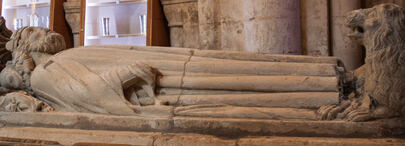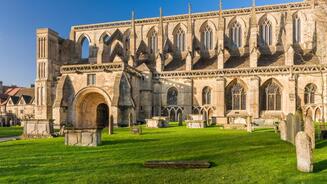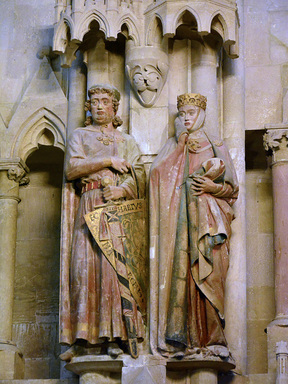|
King Athelstan is considered by many to be the first king of England; he was the grandson of Alfred the Great. He died on this day in 939 and was buried in Malmesbury Abbey in Wiltshire. Athelstan, says the Anglo-Saxon chronicles was 'the lord of warriors and patron of heroes" and by the time of his death, he had secured England’s borders and introduced new laws. Of Athelstan's funeral, 12th-century chronicler William of Malmesbury wrote that 'many gifts in gold and silver were carried before the body, as well as many relics of saints, bought in Brittany, for such were the objects on which he expended the treasure accumulated and left untouched by his father.' William of Malmesbury also viewed the king's remains and of what he saw he wrote 'the king as not above the average height, slim in build with fair hair 'as I have seen for myself in his remains, beautifully intertwined with golden threads.'
0 Comments
On the 5th December in 902 occurred the death of Ealhswith, the wife of Alfred the Great. In the year 869 Alfred was in Gainsborough, he was accompanied there by Burgred who was King of Mercia from 852 until 874. Burgred was the last true independent king of Mercia, whose reign was disrupted by frequent Viking invasions which began almost immediately after he ascended the throne. This Lincolnshire town was the home of Ealhswith, the daughter of Aethelred of the Earldom of Gaini, from were Gainsborough takes its name. Bishop Asser in his biography of Alfred wrote: "was betrothed to and married a wife from Mercia, of noble family, namely the daughter of Æthelred, of the ealdorman of the Gaini. The woman's mother was called Eadburh, from the royal stock of the king of the Mercians. I often saw her myself with my very own eyes for several years before her death. She was a notable woman, who remained for many years after the death of her husband a chaste widow, until her death." Ealhswith married Alfred in Gainsborough and afterwards they feasted at the Gainsborough Castle, home to the Earls of Gaini. Today, the town's castle is long gone but standing on the site is the towns famous Old Hall. Gainsborough remembers Ealhswith with Elswitha Hall a fine town house of red brick which stands next to Gainsborough's Guildhall, overlooking the River Trent. Alfred, it seems, despite famously standing up to the marauding vikings, was a superstitious man, it has been said that he did not wish Ealhswith to be given the title of queen, this was due to the antics of a former queen of Wessex who had the same name who had accidentally poisoned her husband. Ealhswith supported Alfred as king for over thirty years and no doubt during this time Alfred considered his wariness justified. Little is known of Ealhswith life but we do know that she was the mother of five children two of which became great leaders. Aethelflaed her daughter was the ruler of Mercia from 911 until her death, and Edward the Elder was king of England from 899 until 924. On Alfred's death Ealhswith was bequeathed three estates, one was Edington in Wiltshire, which you can see in the images below, where in 879 Alfred fought against an uncoordinated band of Vikings under its leader Guthrum who Alfred later persuaded to convert to Christianity. Ealhswith was commemorated in two 10th century manuscripts where it is written that she was
"the true and dear lady of the English" She was buried in the Benedictine abbey in Winchester that was begun by Alfred but finished by her son Edward the Elder. In 910 a large Viking army raided England's shores, they were defeated by an allied army from Mercia and Wessex under the leadership of Aethelflaed and her brother Edward, the children of Alfred the Great. On the 5th of August, the Battle of Tettenhall, in modern-day Wolverhampton, would be the last major Norse invasion of England. Aethelflaed's husband was Athelred, King of Mercia, it was on his death in 911 that Aethelflaed took the title of "Lady of the Mercians." Her succession has been described as the 'only case of a female ruler of a kingdom in Anglo-Saxon history' and 'one of the most unique events in early medieval history.' Some twenty years earlier Aethelflaed had founded an abbey in Gloucester not too far from the original 7th century St Peter's Abbey. In 909, following a Saxon and Mercian raid into Lindsey, a Danish territory, they seized the remains of Saint Oswald. This relic had rested at Bardney Abbey in Lincolnshire since 642, it was taken to St Peter's Abbey in Gloucester were Aethelflaed renamed it St Oswald’s Priory. Following the Battle of Maserfield, also on the 5th August, St Oswald's remains arrived in Bardney in Lincolnshire, you can read how the abbey's monks refused them entry here. meanderingthroughtime.weebly.com/history-blog/battle-of-maserfield-and-the-death-of-oswald-of-northumbria 23rd November 955: The death of Eadred Anglo-Saxon king of England. The penny in the image above is dated to the reign of King Eadred, on it you can see that the king has his mouth open. I wonder, was the smith who minted this coin depicting the condition that was the cause of his death? The coin certainly shows something being expelled from his mouth. Eadred was the son of Edward the Elder, his brother Edmund had been murdered by a thief in the May of 946 leaving the throne of England to twenty-three-year-old Eadred. Nine years later Eadred was himself dead, he died from some sort of stomach complaint that left him unable to digest food. Because of this ailment, Eadred was forced to chew and then spit out the food, it seems that he only swallowed the liquid. A witness who watched Eadred at mealtimes wrote "Eratque, proh dolor, rex Eadraedus dilectus Dunstani per omne tempus imperii sui nimium languens, ita ut refectionis tempore sorpto succo ciborum reliquam partem parumper dentibus obtritam ab ore rejecisse, et sic saepe convivantibus secum militibus foetentem nausiam exspuendo fecisset." "so that the part of the rest of the meal is in the time of the sorpta the juice of the food from the mouth to the teeth, a minced rejected, stinking and loathsome to be spewed out to the soldiers" Poor Eadred! Despite this, he had some success during his reign especially in the north of the country. He is also credited with defeating the rather frighteningly named Eric Bloodaxe. Eadred is thought not to have married or had any children and therefore his heir was his teenage, and somewhat frisky, nephew Eadwig. Eadred was buried at the Old Minster, Winchester.
In 1603, Scotland and England became one nation. The Union of the Crowns, saw James VI of Scotland become King of England as heir to Elizabeth I. The story of this troubled union continues into our own time, with the unsuccessful referendum on independence in 2014 and recently with the difference of opinion on the Brexit referendum. With this in mind have you ever wondered when the identities of England and Scotland became first became separate? A battle that took place on the 1st of August 937 was the defining point in the history of our two countries identities, it marked the time when a separate English identity was born. It was this day that Athelstan, King Alfred’s grandson, won a decisive victory against an alliance between the Scots and the Vikings at the Battle of Brunanburh. Having successfully taken the last remaining Viking kingdom, Athelstan looked to the north to extend his authority. The allied forces under Olaf Guthfrithson arrived in England at the Humber estuary but were held at bay. With the joint forces of three major countries against him Athelstan was certainly ganged up on, but as historian Michael Woods wrote the Athels 'held his nerve, took the offensive and won a crushing victory.' and the battle, according to the Annals of Ulster was “immense, lamentable and horrible, savagely fought.” King Athelstan, says the Anglo-Saxon chronicles was the "the lord of warriors and patron of heroes" and by the time of his death two years later he had secured England’s borders and introduced new laws. The jury is still out regarding the precise location of Athelstan's victory. According to the Egils Saga, it was fought on a moor called Vin-heath, but where exactly this is is unknown. Yorkshire, Northamptonshire and my home county of Lincolnshire, have all been put forward, but it is Bromborough in the Wirral, in north-west England that most historians agree the battle took place.
The story of Athelstan's heroic fight can be found in the Anglo-Saxon Chronicle and can be listened to here. youtu.be/MeTG2eDmTzs On the 11th November 1100 Edith, or as history knows her Matilda, married Henry I of England. Their marriage followed the death of Henry's brother William Rufus in the New Forest just three months before. It is unknown if Henry had met Matilda before their marriage, but the suggestion is that he may have first seen her at William's court. Previous to her marriage, Matilda had resided in Romsey Abbey in Hampshire, living there under the guidance of Christina, her 'wicked' aunt. Christina had been Abbess of Romsey since 1086 and was Matilda's mother, Margaret of Scotland's sister. Following this Matilda lived at Wilton Abbey, a Benedictine convent in Wiltshire, where she was well educated. Because Matilda's home for the previous fourteen years had been a convent there was a worry that she had taken vows and was a nun, however any objections to the marriage came to nothing and the marriage went ahead. Matilda gave Henry two children, William, whose death in 1120 plunged the country into what has become known as The Anarchy in which Matilda's daughter, also Matilda was embroiled in power struggle with her cousin Stephen over the empty throne of England. Henry I was, to put it politely, a bit of a ladies-man, having numerous illegitimate offspring and as many mistresses, I have often wondered if Henry's philandering was the reason Matilda's children were born in the first four years of their eighteen
year marriage. However, it is more than likely that the lack of other children was a result of a difficult birth. Another thought is that following her fourteen years in a convent she believed, as she was taught, that sex was for the procreation of children and not for pleasure and returned to a life of celibacy or was it the other way around, maybe Matilda's lack of interest in the bedroom was part of the reason Henry went looking else where. Of course, a wife of a king had to accept that his affections were often given to other women and the medieval woman didn't necessarily see sex as a sin, whatever the real reason by her death in 1118 Matilda had only one surviving child but was regarded by her people as a good and saintly woman. 'The Most Beautiful Woman of the German Middle Ages'Not so long ago I came across this beautiful face and I thought "This is probably the prettiest face I have ever seen carved in stone." So taken by her was I, that I was eager to find out who exactly she was. Eventually I found out that she was Uta of Naumburg. I then looked up the word beauty in the dictionary and one definition was "a form that pleases the aesthetic senses, esp. the sight." Didn't the master craftsman who created this image of Uta get that right. Uta of Naumburg was probably born around the turn of the 10th century, she was the daughter of Count Adalbert of Ballenstedt and his wife Hidda, daughter of Hodo I. She was a member of the House of Ascanisan, whose lands covered what today is Saxony and Brandenburg. Her ancestors, the Ascanians, name derives from a medieval Latin variant of the name Castle Aschersleben, which was a hilltop castle in Wolfsberg Germany. Uta had married Ekkehard II of Messen, a nobleman in the court of Henry III the Holy Roman Emperor who reigned from 1046 to 1056. Ekkehard was responsible for securing the German boarder against attacks from Poland andBohemia. Uta's marriage was childless, on their deaths the couple left their estates to Henry III and their great wealth to Naumburg Cathedral in order to help with the construction of a chapel. Uta and her husband are two of twelve nobles who were the founders of the cathedral and in the 13th century, twelve life sized 'donor portraits' were placed on pillars at one end of the cathedral in their honour. Uta died sometime before 1046. Many people over the centuries have noticed Uta's beauty, the late Umberto Eco was asked what woman from European art he would most like to spend the evening, he answered: “In first place, ahead of all others, with Uta von Naumburg.” Walt Disney also was taken with her beauty, look closely at this image of Uta, look first at her face and her clothing see how her collar is raised, and how one hand is supporting a fold in her cloak. Doe's she remind you of any one? Disney used Uta's face in his 1937 film Snow White and the Seven Dwarfs, he took her face, her crown and cloak and used them to create two characters. He changed Uta's face slightly to give us the evil, yet stunning medieval enchantresses, that is the wicked stepmother, and he used her sweet innocent look to create Snow White herself. Uta is said to be the 'most beautiful woman of the German Middle Ages'
Eight centuries ago a stone mason captured Uta's beauty and carved it in limestone for all to see, today there have been numerous photographs taken of her, her image appears in art books and magazines, on postcards and calendars. |
Archives
February 2024
Categories
All
After ten years in the workplace I became a mother to three very beautiful daughters, I was fortunate enough to have been able to stay at home and spend my time with them as they grew into the young women they are now. I am still in the position of being able to be at home and pursue all the interests I have previously mentioned. We live in a beautiful Victorian spa town with wooded walks for the dog, lovely shops and a host of lovely people, what more could I ask for.
All works © Andrea Povey 2014. Please do not reproduce without the expressed written consent of Andrea Povey. |
- Home
-
My Family Stories
- Bustaine of Braunton: Introduction
- Hunt of Barnstaple Introduction >
- Lakeman of Mevagissey >
- Meavy Introduction >
- Mitchell of Crantock: An Introduction >
- Mohun of Dunster: Introduction >
- Purches of Hampshire and Cornwall >
- Scoboryo of St Columb Major >
-
Thomas Vaughan: An Introduction
>
- Smith of Barkby Introduction >
- Taylor Introduction >
- Tosny of Normandy >
- Toon of Leicestershire: Introduction >
- Underwood of Coleorton Introduction
- Umfreville of Devon >
- Other Families
- History Blog
- Wars of the Roses Blog
- The Ancestors
- A to E
- F to J
- K to O
- P to T
- U to Z
- Hendley of Coursehorne Kent
- Pigott Family of Whaddon Buckinghamshire
- Links
- Contact
- Umfreville test

























 RSS Feed
RSS Feed
